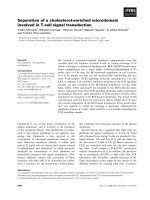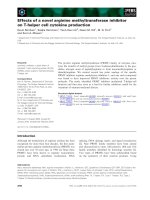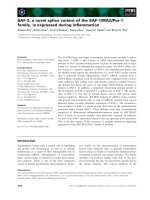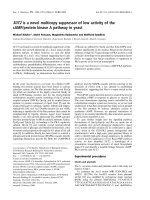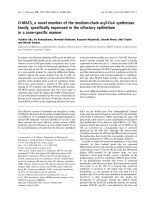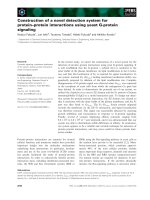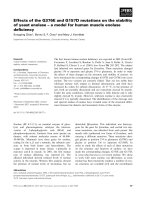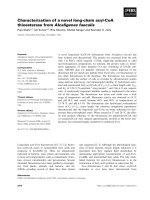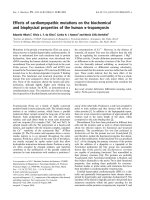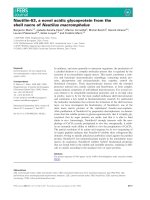Báo cáo khoa học: Effects of a novel arginine methyltransferase inhibitor on T-helper cell cytokine production pot
Bạn đang xem bản rút gọn của tài liệu. Xem và tải ngay bản đầy đủ của tài liệu tại đây (515.49 KB, 13 trang )
Effects of a novel arginine methyltransferase inhibitor
on T-helper cell cytokine production
Kevin Bonham
1
, Saskia Hemmers
1
, Yeon-Hee Lim
2
, Dawn M. Hill
1
, M. G. Finn
2
and Kerri A. Mowen
1
1 Department of Chemical Physiology and Department of Immunology and Microbial Sciences, The Scripps Research Institute, La Jolla, CA,
USA
2 Department of Chemistry and the Skaggs Institute for Chemical Biology, The Scripps Research Institute, La Jolla, CA, USA
Introduction
Although the methylation of arginine residues has been
recognized for more than four decades, the first mam-
malian protein arginine methyltransferase (PRMT) was
cloned just over 10 years ago, in 1996 [1]. Since then,
PRMTs have been shown to regulate transcription,
protein and RNA subcellular localization, RNA
splicing, DNA damage repair, and signal transduction
[2]. Nine PRMT family members have been cloned
and characterized to date, with putative 10th and 11th
family members identified by homology searches [3].
Two types of PRMTs have been subclassified based
on the symmetry of their reaction products. Using
Keywords
cytokines; inhibitors; nuclear factor of
activated T cells interacting protein 45 kDa
(NIP45); protein arginine methyltransferase;
T-helper cell
Correspondence
Kerri A. Mowen, Department of Chemical
Physiology, The Scripps Research Institute,
10550 North Torrey Pines Road, La Jolla,
CA 92037, USA
Fax: +1 858 784 9190
Tel: +1 858 784 2248
E-mail:
M. G. Finn, Department of Chemistry and
the Skaggs Institute for Chemical Biology,
La Jolla, CA 92037, USA
Fax: +1 858 784 8850
Tel: +1 858 784 2087
E-mail: mgfi
(Received 13 August 2009, revised 29
January 2010, accepted 22 February 2010)
doi:10.1111/j.1742-4658.2010.07623.x
The protein arginine methyltransferase (PRMT) family of enzymes cata-
lyzes the transfer of methyl groups from S-adenosylmethionine to the gua-
nidino nitrogen atom of peptidylarginine to form monomethylarginine or
dimethylarginine. We created several less polar analogs of the specific
PRMT inhibitor arginine methylation inhibitor-1, and one such compound
was found to have improved PRMT inhibitory activity over the parent
molecule. The newly identified PRMT inhibitor modulated T-helper-cell
function and thus may serve as a lead for further inhibitors useful for the
treatment of immune-mediated disease.
Structured digital abstract
l
MINT-7710141: Prmt1 (uniprotkb:Q63009) physically interacts (MI:0915) with nip45 (uni-
protkb:
O09130)byanti tag coimmunoprecipitation (MI:0007)
l
MINT-7710127: Prmt1 (uniprotkb:Q63009) physically interacts (MI:0915) with Prmt1 (uni-
protkb:
Q63009)byanti tag coimmunoprecipitation (MI:0007)
Abbreviations
Adox, adenosine dialdehyde; AMI, arginine methylation inhibitor; IL, interleukin; GST, glutathione S-transferase; GST–GAR, GST fused to the
glycine-rich and arginine-rich region of fibrillarin; IFN-c, interferon-c; NFAT, nuclear factor of activated T cells; MTA, methylthioadenosine;
NIP45, NFAT interacting protein 45kDa; PMA, 4b-phorbol 12-myristate 13-acetate; PRMT, protein arginine methyltransferase; SAH,
S-adenosylhomocysteine; SAM, S-adenosylmethionine; siRNA, small interfering RNA; Th, T helper; Th1, Type 1 T-helper; Th2, Type 2
T-helper; TK-Renilla luciferase, thymidine kinase promoter-driven Renilla luciferase.
2096 FEBS Journal 277 (2010) 2096–2108 ª 2010 The Authors Journal compilation ª 2010 FEBS
S-adenosylmethionine (SAM) as the methyl donor,
Type I PRMTs (1,3,4,6,8) catalyze asymmetric modifi-
cation of arginine residues, depositing two methyl
groups on a single guanidine nitrogen atom, and Type
II PRMTs (5,7,9) perform symmetric transfer, placing
one methyl group per terminal nitrogen of the arginine
side chain. Both Type I and Type II PRMTs catalyze
monomethylation as a reaction intermediate [4].
Post-translational modifications within T-cell-recep-
tor signaling cascades allow T lymphocytes to initiate
a rapid and appropriate immune response to patho-
gens. Indeed, co-engagement of the CD28 costimulato-
ry receptor with the T-cell receptor increases PRMT
activity and Vav1 methylation [5]. Perturbation of
PRMT activity through the use of methylation inhibi-
tors leads to diminished Vav1 methylation, as well as
downstream interleukin (IL)-2 production [5]. PRMT5
promotes nuclear factor of activated T cells (NFAT)-
driven promoter activity and IL-2 secretion [6]. Addi-
tionally, arginine methylation regulates cytokine gene
transcription in T helper (Th) cells through arginine
methylation of the NFAT cofactor, NFAT interacting
protein 45 kDa (NIP45) [7]. These results demonstrate
a role for arginine methylation in T-cell function, sug-
gesting that PRMT inhibitors may be valuable for the
treatment of autoimmune diseases.
As SAM is the methylation donor in the PRMT
reaction, the use of SAM analogs is a logical strategy
for the direct inhibition of PRMTs. As a SAM analog,
sinefungin can compete for SAM binding and inhibit
the activity of all SAM-dependent methyltransferases,
including PRMTs [8]. Removal of the methyl group
from SAM yields S-adenosylhomocysteine (SAH),
which is broken down by SAH hydrolase [3]. SAH
also acts as a methyltransferase inhibitor. Compounds
such as (Z)-5¢-fluoro-4¢5¢-didehydro-5¢-deoxyadenosine
(MDL 28,842) and adenosine dialdehyde (Adox),
which hinder SAH hydrolase activity, cause an
increase in SAH and thereby inhibit methylation [9].
Although methylthioadenosine (MTA) was reported to
inhibit methyltransferase activity directly, it is an inef-
ficient direct inhibitor of PRMT activity and is more
likely to act via SAM catabolism [9–11]. Chemicals
such as MDL 28,842, Adox, sinefugin and MTA are
not specific to the PRMT pathways as they inhibit
other SAM-dependent enzymes. Nonetheless, these
inhibitors and similar molecules have been used widely
in arginine methylation studies because of a lack of
better reagents.
A non-nucleoside-specific small-molecule inhibitor of
PRMTs, arginine methylation inhibitor (AMI)-1, was
recently identified by Bedford and coworkers during
screening of a commercial chemical library [8]. Other
inhibitors have been discovered using virtual screening
methods or by creating analogs to molecules in the ori-
ginal AMI-1 study, identifying a variety of potential
PRMT inhibitory structures [12–15]. Our goal was to
generate a less polar version of AMI-1 while maintain-
ing PRMT inhibitor properties, hypothesizing that
such a modification may enhance biological activity.
We describe here the identification of one such com-
pound and the characterization its inhibitory proper-
ties, focusing on its modulation of Th cell function.
Results
Chemistry
In the report disclosing the activity of AMI-1, Bedford
and coworkers also identified the fluorescein triazine
derivative AMI-6 as a selective arginine methyltrans-
ferase inhibitor, and the azo compound, AMI-9, as a
significantly more potent, but unselective, inhibitor of
both lysine and arginine methyltransferases (Fig. 1) [8].
In an effort to develop a more potent selective inhibi-
tor, we melded elements of these two compounds.
Accordingly, nonpolar functionality was conveyed to
the aminonaphthol sulfonate core of AMI-1 by
appending the azo moiety of AMI-9 to one side, giving
compound 1, and the dichlorotriazine group of AMI-6
to the other side, giving compound 4. The Fmoc inter-
mediate compound 2 was also tested, as were the iso-
propyl sulfonate esters, compounds 3 and 5, to assay
the importance of the sulfonate negative charge and
the possibility of providing a nonpolar prodrug form
of the active charged species (Fig. 1).
Characterization of PRMT inhibitors
To test the inhibitory activity of the compounds, we
compared the ability of recombinant rat glutathione
S-transferase (GST)–PRMT1 or recombinant human
GST–PRMT4 to methylate histone 4 or histone 3,
respectively, giving the IC
50
values shown in Table 1.
AMI-1 was a more effective inhibitor of PRMT1 than
PRMT4 (Table 1). Compounds 1, 2, 4 and 5 inhibited
both PRMT1 and PRMT4, with the latter enzyme being
more sensitive to the added compounds. Comparisons
between compounds 2 versus 3 and compounds 4 versus
5 demonstrated that the charged sulfonate group is
advantageous. The triazine derivative compound 4 was
most potent, with an IC
50
of 4.15 lm for PRMT1 and
an IC
50
of 2.65 lm for PRMT4 (Table 1), similar to the
reported IC
50
value of 8.8 lm of the parent compound
AMI-1 for human PRMT1. Further investigations
focused on compound 4.
K. Bonham et al. Modulation of T-helper cell function by AMI-1
FEBS Journal 277 (2010) 2096–2108 ª 2010 The Authors Journal compilation ª 2010 FEBS 2097
We determined the specificity of compound 4 by
evaluating its effects on a panel of catalytically active
recombinant Type I PRMTs using AMI-1 for compari-
son (Fig. 2A,B). Using in vitro methylation assays with
increasing concentrations of inhibitory compounds,
compound 4 proved effective against PRMT1, PRMT3
and PRMT4. The substrate identity influenced the
inhibitory activity of AMI-1, which most potently
inhibited PRMT1 methylation of GST–GAR (GST
fused to the glycine-rich and arginine-rich region of
fibrillarin) compared with histone 4 (Fig. 2A, top two
panels). The published AMI-1 IC
50
value for PRMT1
was determined using the glycine-rich and arginine-rich
GST–Npl3 substrate [8]. Compound 4 prevented the
methylation of GST–GAR by PRMT6 and PRMT8,
while AMI-1 was less effective against these enzymes
(Fig. 2B). Next, we examined the potency of com-
pound 4 on Type II PRMTs. As the activity of recom-
binant PRMT5 is several hundred-fold lower than the
activity of PRMT5 isolated from mammalian cells, we
performed methyltransferase assays using PRMT5
immunoprecipitated from 293T cells. [16]. While com-
pound 4 inhibited the activity of PRMT5, AMI-1 was
ineffective as a PRMT5 inhibitor (Fig. 2C). In addi-
tion, compound 4 was selective for arginine meth-
yltransferases over the SET domain-containing H3K4
lysine methyltransferase SET7 ⁄ 9, requiring at least
30-fold higher concentrations to inhibit recombinant
SET7 ⁄ 9 activity relative to compound 4 inhibition of
PRMT1 (Fig. 2A,C).
As SAM serves as the methyl donor in PRMT-depen-
dent methylation reactions, we examined whether com-
pound 4 inhibits PRMT activity by competing for SAM
binding. Recombinant PRMT1 was incubated in the
N
N
NH
2
N
N
O
OHOH
S
Me
Methylthioadenosine (MTA)
N
N
NH
2
N
N
O
OHOH
S
Me
O
2
C NH
3
S-adenosylmethionine (SAM)
N
N
NH
2
N
N
O
OHOH
H
3
N
O
2
C NH
3
Sinefungin
AMI-1
OH
NaO
3
S N
H
N
H
O
OH
SO
3
Na
OH
NaO
3
S NH
2
N
N
MeO
1
OH
R
N
H
N
N
MeO
2
(R = SO
3
Na)
O
O
3
(R = SO
3
CHMe
2
)
OH
R
N
H
N
N
MeO
N
NN
Cl
Cl
4
(R = SO
3
Na)
5
(R = SO
3
CHMe
2
)
O
OHO
HO
2
C
N
H
N
NN
Cl
Cl
AMI-6
N
N
HO
CO
2
H
Me
2
AMI-9
Fig. 1. Known PRMT inhibitors and compounds synthesized in this study. Chemical structures of SAM, MTA, sinefungin, AMI-1, AMI-6,
AMI-9 and compounds 1-5.
Table 1. Inhibition of histone methylation by PRMT1 and PRMT4
in the presence of the compounds depicted in Fig. 1.
Compound PRMT1 IC
50
PRMT4 IC
50
AMI-1 8.8 lM
a
169.8 ± 10.7 lM
1 397.3 ± 44.2 lM 196 ± 19.8 lM
2 332.5 ± 79 lM 56.1 ± 14.6 lM
3 No inhibition No inhibition
4 4.15 ± 1.6 l
M 2.65 ± 0.6 lM
5 56.7 ± 10.9 lM 52.4 ± 6.6 lM
a
reported value using recombinant hPRMT1 and GST-Npl3 as sub-
strate [8].
Modulation of T-helper cell function by AMI-1 K. Bonham et al.
2098 FEBS Journal 277 (2010) 2096–2108 ª 2010 The Authors Journal compilation ª 2010 FEBS
presence of radiolabeled SAM and a 50-fold molar
excess of sinefungin, AMI-1, or compound 4, followed
by UV irradiation to cross-link the bound SAM to the
protein. As previously published, the SAM analog, sine-
fungin, was competitive with SAM for binding, whereas
AMI-1 was not [8]. Analysis by SDS ⁄ PAGE and visual-
ization by fluorography (Fig. 3A) revealed that com-
pound 4 did not block SAM binding to PRMT1.
PRMT1 has been shown to form dimers in crystal
structure studies, and mutations within the dimeriza-
tion interface reduce methyltransferase activity [4,17].
To test the possibility that compound 4 inhibits
PRMT1 activity by preventing oligomerization, we
performed co-immunoprecipitation experiments
(Fig. 3B). Equal volumes of HA–PRMT1- and
FLAG–PRMT1-transfected 293T-cell lysates were
mixed and incubated with dimethylsulfoxide (lane 2),
AMI-1 (100 lm (lane 3) or compound 4 (100 lm) (lane
4) during the co-immunoprecipitation. Specificity of
the HA–PRMT1 ⁄ FLAG–PRMT1 interaction was
determined using an empty HA vector (Fig. 3B, lane 1).
The presence of either compound did not interfere
with the interaction between HA–PRMT1 and FLAG–
PRMT1, indicating that compound 4 does not inter-
fere with PRMT1 oligomerization.
To examine whether compound 4 is a reversible
inhibitor, we performed washout experiments. Recom-
binant GST–PRMT1 bound to glutathionine beads
was pre-incubated with compound 4 (100 lm) or AMI-
1 (100 lm). The beads were then washed with methyla-
tion buffer only (Fig. 3C, indicated by ‘)’) or with
methylation buffer containing the indicated compound
(Fig. 3C, indicated by ‘+’) before methylation reac-
tions using calf thymus histones as a source of the
PRMT1 substrates histone 4 and histone 2A [18]. Inhi-
bition by both compound 4 and AMI-1 was relieved
by the washout, demonstrating that both are reversible
PRMT inhibitors.
Biological activity
To determine whether compound 4 is cell permeable,
we examined the effect of compound 4 on cellular
PRMT activity. 293T cells were incubated with
dimethylsulfoxide, compound 4, or the general methyl-
ation inhibitor Adox [8]. Cell extracts were immunob-
lotted and incubated with an antibody recognizing
H3R17 methylation (Fig. 4). Over this period no cellu-
lar toxicity with these treatments was observed (data
not shown). At 100 lm, compound 4 induced more
Compd 4
(30 μ
M)
AMI-1
(30 μ
M)
DMSO
PRMT6/GST-GAR
PRMT8/GST-GAR
DMSO
100300 30 3 0.3 :μM
AMI-1
Compd 4
SET7/9
Sinefungin
DMSO
Compd 4 AMI-1
300 30 3 0.3 0.03 300 30 3 0.3 0.03
PRMT1/H4
PRMT4/H3
:μ
M
PRMT3/GST-GAR
PRMT1/GST-GAR
IP: PRMT5IP: IgG
Compd 4
(30 μ
M)
AMI-1
(30 μ
M)
DMSO
Compd 4
(30 μ
M)
AMI-1
(30 μ
M)
DMSO
MBP substrate
IB: PRMT5
input
IP
IgG PRMT5
Enzyme/Substrate
AB
CD
Enzyme/Substrate
Enzyme:
Fig. 2. Comparison of AMI-1 and compound 4 inhibitory activities. (A) In vitro methylation reactions of recombinant GST–PRMT1, GST–
PRMT3 and GST–PRMT4 with the indicated substrate and [
3
H]SAM in the presence of increasing concentrations of AMI-1 or compound 4
(Compd 4). (B) In vitro methylation reactions of recombinant GST–PRMT6 or GST–PRMT8 together with GST–GAR and [
3
H]SAM in the pres-
ence of 30 l
M AMI-1 or compound 4. (C) Immunoprecipitated (IP) PRMT5 or isotype control from 293T-cell extracts was subjected to in vitro
methylation reactions using the indicated concentrations of AMI-1 or compound 4 and MBP as substrate (left panel). Reaction inputs were
determined by immunoblotting with PRMT5 antisera (right panel). (D) In vitro methylation reactions of recombinant Set7 ⁄ 9 with calf thymus
histones as substrate and [
3
H]SAM in the presence of increasing concentrations of AMI-1 or compound 4. Data are representative of at least
three independent experiments. DMSO, dimethylsulfoxide.
K. Bonham et al. Modulation of T-helper cell function by AMI-1
FEBS Journal 277 (2010) 2096–2108 ª 2010 The Authors Journal compilation ª 2010 FEBS 2099
than 40% reduction in H3R17 methylation, a signifi-
cant increase in inhibitory activity relative to AMI-1.
Because compound 4 interferes with cellular PRMT
activity, we examined its effects on PRMT-dependent
gene regulation. Type 1 T-helper (Th1) cells modulate
the immune response largely by the secretion of inter-
feron-c (IFN-c), while type 2 T-helper (Th2) cells
secrete IL-4 [19]. PRMTs have been shown to regulate
Th-cell activation and cytokine secretion [5,7,20].
Indeed, PRMT1 augments both IFN-c and IL-4 pro-
moter activity, and general methylation inhibitors
decrease IFN-c and IL-4 transcript levels [7]. We
examined the effect of compound 4 on the cytokine
expression of Th1 and Th2 cells (Fig. 5). As shown
previously, MTA diminished the production of both
IFN-c and IL-4 (Fig. 5A) [7]. Treatment with com-
pound 4 reduced the production of IFN- c from Th1
cells by more than 60% and the levels of IL-4 from
Th2 cells by more than 75%, while incubation with
AMI-1 reduced Th-cell cytokine expression by less
than 40%. Compound 4 inhibited IFN-c secretion by
Th1 cells and IL-4 secretion by Th2 cells in a dose-
dependent manner, with significant effects seen at
10 lm for IFN-c secretion and at 0.1 lm for IL-4
secretion (Fig. 5B). Thus, IL-4 production is more
sensitive than IFN-c production to treatment with
compound 4. Importantly, compound 4 did not affect
Th-cell viability (Table 2). Indeed, both AMI-1 and
compound 4 enhanced Th-cell proliferation, the latter
to a greater degree, suggesting a possible correlation
between PRMT inhibition and T-cell proliferation,
while MTA treatment inhibited T-cell proliferation
(Fig. 5C). Thus, the reduced Th-cell cytokine expres-
sion following treatment with AMI-1 or compound 4
is not a result of increased cell death or reduced cell
numbers.
As compound 4 is a cell-permeable PRMT inhibitor
capable of modulating Th-cell cytokine secretion, it
could suppress IL-4 levels by altering promoter activa-
tion or by affecting RNA stability. Accordingly, we
tested the effect of compound 4 on the activity of a
Th2 selective region of the I L-4 promoter ()760 t o +68),
which is responsive to transactivation by NFATc2 and
GST-PRMT1
DMSO
Sinefungin
AMI-1
Compound 4
AB
Histones
DMSO AMI-1 Compd 4
+–––++
: Compound
wash
C
HA-PRMT1
FLAG-PRMT1
IB: FLAG-PRMT1
IB: HA-PRMT1
DMSO
DMSO
AMI-1
Compd 4
HA
FLAG-PRMT1
HA-PRMT1
+– ––
–+ ++
+
+
+
IP: HA-PRMT1
+
12 34
Fig. 3. Characterization of compound 4 inhibitory activity. (A) GST–PRMT1 was UV cross-linked to [
3
H]SAM in the presence of dimethylsulf-
oxide (DMSO), sinefugin (100 l
M), AMI-1 (100 lM) or compound 4 (100 lM), separated by SDS ⁄ PAGE and visualized by fluorography. (B)
293T cells were transfected with HA–PRMT1 or FLAG–PRMT1. Lysates from the FLAG–PRMT1 transfection were incubated with HA–
PRMT1 immunoprecipitates (IP) in the presence of dimethylsulfoxide (lane 2), AMI-1 (100 l
M, lane 3) or compound 4 (Compd 4) (100 lM,
lane 4), resolved by SDS ⁄ PAGE and the immunoblot was incubated with an antibody to FLAG. Reprobing the immunoblot with an antibody
to HA demonstrated equal loading. Specificity of the HA–PRMT1 ⁄ FLAG–PRMT interaction was determined by incubating immunoprecipitates
from vector-only transfected cells with FLAG–NIP45 lysates (C) Incubations of GST–PRMT1 glutathione beads with dimethylsulfoxide, AMI-
1, or compound 4 were divided into two aliquots. Bead aliquots were washed in either the presence (+) or absence ()) of the indicated com-
pounds. Washed aliquots were immediately subjected to in vitro methylation assays using calf thymus histones. Data are representative of
three independent experiments.
Histone 3
Me
2
-histone 3 (R17)
DMSO
AMI-1 Compd 4
Adox
100 100300 300
:μM
DMSO
AMI-1
(100 μ
M)
AMI-1
(300 μ
M)
Compd 4
(300 μ
M)
Compd 4
(100 μ
M)
Adox
0
20
40
60
80
100
Me
2
-
R
1
7
-
H
3
level
(
%)
Fig. 4. Compound 4 is cell permeable. 293T cells were treated
with dimethylsulfoxide (DMSO), AMI-1 (100 or 300 l
M), compound 4
(Compd 4) (100 or 300 l
M), or Adox (20 lM) for 24 h. Histone
extracts were immunoblotted for H3R17 methylation (left panel).
Quantification of the methylation levels of compound-treated sam-
ples relative to vehicle-treated samples is depicted in the right
panel. Data are representative of three independent experiments.
Modulation of T-helper cell function by AMI-1 K. Bonham et al.
2100 FEBS Journal 277 (2010) 2096–2108 ª 2010 The Authors Journal compilation ª 2010 FEBS
its binding partner NIP45 [21]. We transfected Jurkat
cells, a human T-cell line that contains endogenous
IL-4 promoter transactivating factors, with an IL-4
luciferase reporter. The transfected cells were incu-
bated with dimethylsulfoxide, compound 4, AMI-1
and Adox (Fig. 6A). As expected, Adox greatly dimin-
ished the promoter reporter activity of IL-4 [7].
Incubation with AMI-1 decreased the promoter activ-
ity, while compound 4 diminished the IL-4 promoter
activity even further. Incubation with compound 3,
which did not exhibit in vitro PRMT inhibitory activity
(Table 1), also did not interfere with IL-4 promoter
activity (Fig. 6B). These data support the notion that
the decrease in production of IL-4 by Th2 cells
occurred, at least in part, at the transcriptional level.
The nuclear protein, NIP45, was isolated by virtue
of its ability to interact with NFATc2 in a yeast two-
hybrid screen [21]. NIP45 has been reported to com-
bine with two critical Th2 transcription factors, c-Maf
and NFATc2, to induce the expression of IL-4 in a
normally non-IL-4-producing cell line [21]. NIP45 con-
tains an arginine-rich amino terminus, which is a sub-
strate of PRMT1. Arginine methylation facilitates the
interaction between NIP45 and NFAT, thereby aug-
menting cytokine expression [7]. As a transcriptional
co-activator, PRMT1 is recruited to the NFAT com-
plex via NIP45, forming a tripartite complex that
probably serves to enhance NFAT-driven transcrip-
tional activity [7,22]. Inhibition of methyltransferase
activity by MTA treatment diminished the
PRMT1 ⁄ NIP45 interaction [7]. To determine whether
inhibition of PRMT activity by compound 4 would
also disrupt the PRMT1 ⁄ NIP45 association, 293T cells
were transfected with HA–PRMT1 and FLAG–NIP45,
and co-immunoprecipitation assays were performed.
As predicted, Adox treatment reduced the association
between PRMT1 and NIP45 compared to incubation
with the compound vehicle dimethylsulfoxide (Fig. 6C,
compare lanes 3 and 4). Additionally, both AMI-1 and
compound 4 interfered with the NIP45 and PRMT1
**
*
**
**
**
**
*
**
**
**
DMSO 0.1 μM 10 μM 50 μM 100 μM
0
20
40
60
IFNγ (ng·mL
–1
)
DMSO 0.1 μM 10 μM 50 μM 100 μM
0
2
4
6
IL-4 (ng·mL
–1
)
*
*
*
*
**
**
DMSO MTA AMI-1 Compd 4
0
20
40
60
80
A
B
C
IFNγ (ng·mL
–1
)
DMSO MTA AMI-1 Compd 4
0
1
2
3
4
5
IL-4 (ng·mL
–1
)
DMSO MTA AMI-1 Compd 4
0.0
0.2
0.4
0.6
0.8
Absorbance (490 nm)
Fig. 5. Effects of compound 4 on Th cell
function and proliferation. (A) Th1 cells or
Th2 cells were stimulated with plate-bound
anti-CD3 in the presence of dimethylsulf-
oxide (DMSO), MTA (100 l
M), AMI-1 (100 lM)
and compound 4 (Compd4) (100 l
M). Super-
natants were analyzed by ELISA to deter-
mine the production of IFN-c by Th1 cells
(left panel) or the production of IL-4 by Th2
cells (right panel). (B) Th1 cells or Th2 cells
were stimulated with plate-bound anti-CD3
in the presence of dimethylsulfoxide or vary-
ing concentrations of compound 4, and
IFN-c (left panel, Th1 cells) or IL-4 (right
panel, Th2 cells) levels were determined by
ELISA. (C) Th cells were stimulated with
plate-bound anti-CD3 in the presence of
dimethylsulfoxide, MTA, AMI-1, or
compound 4. Cellular proliferation was
determined using the MTS [3-(4,5-
dimethylthiazol-2-yl)-5-(3-carboxymethoxy-
phenyl)-2(4-sulfophenyl)-2H-tetrazolium]
assay. *P < 0.05, **P < 0.01. Data are
representative of at least three
independent experiments.
Table 2. Viability of T helper cells in the presence of MTA or com-
pound 4.
Per cent
viable
Per cent
apoptotic
Per cent
necrotic
Dimethylsulfoxide 95.9 2.2 2.0
MTA (100 l
M) 90.9 4.9 4.2
cpd 4 (100 l
M) 94.2 1.7 3.0
K. Bonham et al. Modulation of T-helper cell function by AMI-1
FEBS Journal 277 (2010) 2096–2108 ª 2010 The Authors Journal compilation ª 2010 FEBS 2101
interaction, supporting the notion that both are bona
fide arginine methyltransferase inhibitors (Fig. 6C,
lanes 5–8). These data suggest that compound 4 may
diminish the production of IL-4 by Th2 cells, at least
in part, by interfering with the function of NIP45.
Discussion
Here, we have identified compound 4 as a selective
PRMT inhibitor that targets both Type I and Type II
PRMTs. The effectiveness of compound 4 on PRMT1
inhibition was dependent upon the substrate used, with
methylation of GST–GAR being more responsive to
inhibition than histone 4. A histone 4 and an arginine-
rich and glycine-rich peptide were recently compared in
kinetic studies with PRMT1. The K
m
of the histone 4
peptide was about 10-fold lower than that of the
arginine-rich and glycine-rich peptide, suggesting that
the inhibition threshold may differ between PRMT1
substrates [10]. Compound 4 is a reversible inhibitor,
limiting its in vivo toxicity. Also, compound 4 was mostly
inactive against the lysine methyltransferase, Set7 ⁄ 9, in
methylation assays. Importantly, compound 4 potently
inhibited cellular H3R17 methylation, supporting the
notions that compound 4 is cell permeable and is
capable of inhibiting endogenous PRMT activity. It is
0
2000
4000
6000
8000
10 000
12 000
14 000
16 000
18 000
A
C
B
DMSO AMI-1 Cpd 4 Adox
0
500
1000
1500
2000
2500
3000
DMSO Cpd 3 Cpd 4
Relative light units
Relative light units
*
**
**
**
IB: FLAG-NIP45
IB: HA-PRMT1
Input: FLAG-NIP45
12 5634 78
DMSO
HA
FLAG
FLAG-NIP45
HA-PRMT1
++–+++++
–+++++++
––+–––––
+–––––––
Adox
AMI-1 Cpd 4
0
10
20
30
40
50
60
70
80
90
100
DMSO Adox Cpd 4
(100 μ
M)
Cpd 4
(300 μM)
AMI-1
(100 μM)
AMI-1
(300 μM)
Methylation level (%)
IP ctls
100 μM
300 μM
300 μM
100 μM
IP: HA-PRMT1
Fig. 6. Compound 4 inhibits IL-4 promoter activity and the interaction between NIP45 and PRMT1. (A) Jurkat cells were transfected with
the IL-4 luciferase reporter (3 lg) along with the TK-Renilla luciferase vector (10 ng) as an internal control. Transfectants were pretreated
with dimethylsulfoxide (DMSO), AMI-1 (100 l
M), compound 4 (Cpd 4) (100 lM), or Adox (20 lM) for 18 h before stimulation for 6 h with
PMA ⁄ ionomycin. Luciferase values were calculated relative to TK-Renilla luciferase internal controls. Similar results were obtained in at least
three independent experiments. *P < 0.05, **P < 0.01. (B) The same procedure was followed as described for Fig. 6A except that cells
were treated with compound 3 (Cpd 3) (100 l
M) or compound 4 (100 lM). **P < 0.01. (C) 293T cells transfected with HA–PRMT1 and
FLAG–NIP45 expression vectors were treated with dimethylsulfoxide (lane 3), Adox (20 l
M, lane 4), AMI-1 (100 lM, lanes 5–6), or compound
4 (100 l
M, lanes 7–8). Lysates were immunoprecipitated with anti-HA agarose, and immunoprecipitates were probed for FLAG–NIP45 using
an antibody recognizing the FLAG epitope (top panel). HA–PRMT immunoprecipitate levels were evaluated by reblotting with an antibody to
HA (middle panel). The bottom panel demonstrates FLAG–NIP45 input levels. Quantification of FLAG–NIP45 ⁄ HA–PRMT association levels
are depicted relative to the dimethylsulfoxide-treated sample (right panel). Data are representative of three independent experiments.
Modulation of T-helper cell function by AMI-1 K. Bonham et al.
2102 FEBS Journal 277 (2010) 2096–2108 ª 2010 The Authors Journal compilation ª 2010 FEBS
important to note that AMI-1 was first identified as an
HIV-1 reverse transcriptase inhibitor [23]. Therefore, it
will be important to determine whether compound 4,
as a derivative of AMI-1, is a selective inhibitor of
endogenous PRMT activity.
The hybrid structure of compound 4 incorporates
features of the AMI-1, AMI-6 and AMI-9 compounds
described by Bedford and colleagues [8]. AMI-1,
AMI-6 and AMI-9 were all effective methyltransferase
inhibitors. Only AMI-1 and AMI-6 demonstrated
selectivity for the PRMTs, although AMI-6 was mini-
mally active against a cellular PRMT substrate [8].
Computational modeling suggested that AMI-1 spans
the SAM-binding and arginine-binding pockets of
PRMT1; however, AMI-1 did not compete for
[
3
H]SAM binding to recombinant PRMT1 [8,24]. Addi-
tionally, in a study using peptide-based fluorescent
reporters, AMI-1 blocked PRMT1 binding to its sub-
strate [25]. The mechanism of action of compound 4 is
not completely clear, but it neither competed with
SAM binding nor blocked PRMT1 dimerization.
In the first report of specific small-molecule PRMT
inhibitors, Bedford and coworkers used an antibody-
based high-throughput screening to identify several
AMIs (Table 2) [8]. Of these, AMI-1 showed interest-
ing selectivity by not inhibiting the lysine methyltrans-
ferase Set7 ⁄ 9 but was only weakly cell permeable,
limiting its use in vivo [8]. In follow up studies, the
bromo-moiety containing the AMI-5 structure was
used as a template to create several new inhibitors with
similar potency to AMI-1 (at low micromolar concen-
trations) [14,15]. Using 26 AMI analogs, one low-
micromolar PRMT1 inhibitor was identified, and
cellular activity was not reported [24]. Virtual ligand
screening using the published PRMT1 structure has
resulted in several novel compounds with inhibitory
activity (thyglycolic amide, allantodapsone) [12,13].
Thompson and coworkers generated PRMT1 inhibi-
tors using in situ bisubstrate generation (D2AAI), but
none of these compounds was more potent than AMI-
1 [26]. Recently, both Methylgene and Bristol-Myers
Squibb have reported high-potency (picomolar IC
50
)
and selective PRMT4 inhibitors, although the Methyl-
gene compound was not active in cellular assays and
no cellular data were reported for the Bristol-Myers
Squibb compounds [27–29]. Additionally, we found
that while compound 4 inhibits both Type I and Type
II PRMTs, AMI-1 distinguishes between the two
PRMT subclasses. Thus, a variety of chemical struc-
tures can serve as PRMT inhibitors, and highly potent
and selective PRMT structures are achievable.
The NFAT interacting protein, NIP45, is also a
PRMT1 substrate [7]. Arginine methylation of NIP45
promotes NFAT-driven transcription [7]. In previous
studies, we used MTA treatment to support a role for
PRMTs in Th-cell cytokine expression [7]. Using
compound 4, we have extended these earlier studies,
showing that methyltransferase inhibition results in the
inhibition of IFN-c and IL-4 production, interference
with IL-4 promoter activity and impairment of the
interaction between PRMT1 and NIP45.
Several lines of evidence strongly suggest that spe-
cific PRMT inhibitors may be valuable for the treat-
ment of autoimmune diseases such as rheumatoid
arthritis [5–7,30–33]. PRMTs modify and regulate sev-
eral critical immunomodulatory proteins. Post-transla-
tional modifications within T-cell-receptor signaling
cascades allow T lymphocytes to initiate a rapid
and appropriate immune response to pathogens.
Co-engagement of the CD28 costimulatory receptor
with the T-cell receptor elevates PRMT activity and
cellular protein arginine methylation, including methyl-
ation of the guanine nucleotide exchange factor Vav1
[5]. Incubation with MDL 28,842 diminished methyla-
tion of the guanine exchange factor, Vav1, as well as
IL-2 production. Similarly, MTA treatment and small
interfering RNA (siRNA) directed against PRMT5
both inhibited NFAT-driven promoter activity and
IL-2 secretion [6]. We also demonstrated that arginine
methylation of the NFAT cofactor, NIP45, within
Th cells by PRMT1 promotes its association with
NFAT, thereby driving NFAT-mediated cytokine gene
expression [7]. In fibroblast cell lines, PRMT1 also
co-operates with Carm1 to enhance nuclear factor-jB
(NF-jB) p65-driven transcription and facilitate the
transcription of p65 target genes such as tumor necro-
sis factor-a (TNF-a) [32]. Symmetric dimethylation of
Sm D1 and D3 forms an epitope for the production of
anti-Sm autoantibodies, which are often found in lupus
[30,31,33]. Taken together, these results demonstrate
an important role for arginine methylation in inflam-
mation, suggesting that PRMT inhibitors may be
valuable for the treatment of autoimmune diseases.
Inhibition of PRMT activity using AMI-1 or com-
pound 4 augmented Th-cell proliferation. It will be
important to determine whether compound 4 also
enhances the proliferation of transformed cells. The
combination of compound 4 treatment along with a
PRMT siRNA approach may provide some insight into
the mechanism behind this phenomenon. Because
PRMT activity promotes Th-cell cytokine production,
compound 4 and more potent derivatives thereof may be
useful for treating Th-cell-driven autoimmune diseases,
such as multiple sclerosis. Further work to develop more
potent derivatives is underway, guided by docking stud-
ies of compound 4 to the PRMT1 crystal structure.
K. Bonham et al. Modulation of T-helper cell function by AMI-1
FEBS Journal 277 (2010) 2096–2108 ª 2010 The Authors Journal compilation ª 2010 FEBS 2103
Materials and methods
Mice and cell culture
BALB ⁄ c mice were obtained from The Scripps Research
Institute breeding colony. All animal protocols were in
accordance with The Scripps Research Institute Institutional
Animal Care and Use Committee policy. Th cells were iso-
lated using magnetic bead selection (Miltenyi Biotech, Ber-
gisch Gladbach, Germany). T cells were cultured in RPMI
and stimulated with plate-bound anti-CD3 (1 lgÆmL
)1
)
(2C11; BioXCell) plus anti-CD28 (2 lgÆ mL
)1
) (PV1; Bio-
XCell, West Lebanon, NH, USA), in the presence of IL-2
(NCI Biological Resources Branch). For Th1 skewing,
5ngÆmL
)1
of recombinant IL-12 (14-8121; eBiosciences, San
Diego, CA, USA) and 10 lgÆmL
)1
of anti-IL-4 (11B11; NCI
Biological Resources Branch, Frederick, MD, USA) were
added to the cell culture, and for Th2 skewing, 10 ngÆmL
)1
of recombinant IL-4 (14-8041; eBiosciences) and 10 lgÆmL
)1
of anti-IFN-c (R4 ⁄ GA2; BioXCell) were added to the cell
culture. For stimulation with 4b-phorbol 12-myristate
13-acetate (PMA) ⁄ ionomycin, cells were incubated with
50 ngÆmL
)1
of PMA and 1 mm ionomycin (EMD Bioscienc-
es, Gibbstown, NJ, USA). Compounds were dissolved in
dimethylsulfoxide. AMI-1 (AK Scientific, Mountain View,
CA, USA and EMD Biosciences), Adox (Sigma, St Louis,
MO, USA), MTA (Sigma) and sinefungin (Sigma) were solu-
bilized in dimethylsulfoxide. Jurkat cells were grown in
RPMI. 293T cells were grown in Dulbecco’s modified Eagle’s
medium (DMEM). Proliferation assays were performed
using the CellTiter 96 Aqueous One Solution Proliferation
Assay reagent (Promega, Madison, WI, USA).
Plasmids, transfections and luciferase assays
GST–PRMT1 and GST–CARM1 vectors were described
previously [1,34]. We thank Drs H. Herschman, S. Richard,
M. Bedford and S. Clarke for GST–PRMT3, GST–PRMT6,
GST–PRMT8 and GST–GAR vectors, respectively. Expres-
sion vectors for FLAG–PRMT1, HA–PRMT1, FLAG–
NIP45 and IL-4 luciferase were described previously [7].
Transient transfection of 293T cells was performed using
Fugene HD (Roche, Basel, Switzerland), according to the
manufacturer’s instructions. Jurkat cells were transfected
using a BioRad electroporator (Hercules, CA, USA) (280 V,
975 lF). Thymidine kinase promoter-driven Renilla lucifer-
ase (TK-Renilla luciferase) was used as an internal control.
Luciferase activity was determined using Promega’s Dual
Luciferase Kit.
ELISA
Th1 or Th2 cells (1 · 10
6
cellsÆmL
)1
) from day 7 cultures
were stimulated with plate-bound anti-CD3 (1 lgÆmL
)1
) for
24 h. IL-4 or IFN-c protein levels in cell supernatants were
measured using ELISA, as described previously (eBio-
sciences) [7].
In vitro methylation assays
Recombinant GST–PRMT1, GST–PRMT3, GST–PRMT4,
GST–PRMT6, GST–PRMT8 and GST-GAR were pre-
pared as described previously [21] and concentrated using a
micron 10 filter device (Millipore, Billerica, MA, USA).
Set7 ⁄ 9 (ALX-201-178) was purchased from Enzo Life Sci-
ences. Methylation reactions were performed, as described
previously, using recombinant histone 3 (12-357; Millipore),
histone 4 (12-347; Millipore), or calf thymus histones
(H4380; Sigma) [7]. The reactions were quantified by densi-
tometry (imagej software, National Institutes of Health,
Bethesda, MD, USA) and the IC
50
values were calculated
using linear regression.
Antibodies, immunoprecipitations and
immunoblots
Whole-cell lysates were prepared using 1% Triton X-100 lysis
buffer. For co-immunoprecipitation experiments, cell lysates
were prepared in a lysis buffer containing 100 mm NaCl,
50 mm Tris (pH 7.5), 1 mm EDTA, 0.1% Triton X-100,
10 mm NaF, 1 mm phenylmethanesulfonyl fluoride and
1mm vanadate. Immunoprecipitations were performed using
anti-HA agarose (Sigma). The primary antibodies used in
these studies were: anti HA–HRP (12CA5; Roche), anti-
FLAG–HRP (M2; Sigma), anti-b-actin (ab8226; Abcam)
and anti-histone 3 dimethylarginine 17 (07-214; Millipore).
Inhibitor reversibility assay
GST–PRMT1 bound to glutathione–agarose beads was
incubated for 60 min on ice in the presence of 100 l m com-
pounds. Samples were then washed three times with methyl-
ation reaction buffer (20 mm Tris, pH 8.0, 200 mm NaCl,
0.4 mm EDTA) containing either 100 lm inhibitor or
dimethylsulfoxide. Samples were resuspended in methy-
lation reaction buffer containing 100 lm inhibitor or
dimethylsulfoxide, 1 lg of histones and 6 lm S-adenosyl-
[methyl-
3
H]methionine. The reactions were incubated for
90 min at room temperature and stopped with SDS
sample buffer. Fluorography was performed as described
previously [35].
Crosslinking
GST–PRMT1 (10 lg) was suspended in NaCl ⁄ P
i
(PBS) con-
taining 5 mm dithiothreitol, 100 lm inhibitor (sinefungin,
AMI-1 or compound 4) and 20 lm S -adenosyl-
[methyl-
3
H]methionine, and added to a 96-well plate
Modulation of T-helper cell function by AMI-1 K. Bonham et al.
2104 FEBS Journal 277 (2010) 2096–2108 ª 2010 The Authors Journal compilation ª 2010 FEBS
precooled on ice. Wells were exposed to short-wave UV light
(UVP Inc. Model #UVGL-25, Upland, CA, USA) for 1 h.
Fluorography was performed as described previously [8].
Synthesis
All air-sensitive and moisture-sensitive reactions were per-
formed under nitrogen in oven-dried or flame-dried glass-
ware. Unless stated otherwise, reagents and solvents were
purchased from VWR, Acros, TCI America, or Aldrich,
and were used without further purification. All experiments
were monitored by TLC with visualization by exposure to
UV light, iodine vapor, or a staining solution (5% phos-
phomolybdic acid in ethanol, anisaldehyde in EtOH, or
aqueous KMnO
4
) followed by heating. Flash chromatogra-
phy was performed using SINGLE StEP pre-packed med-
ium pressure liquid chromatographic columns (Thomson
Instrument Company, Oceanside, CA, USA). Melting
points were determined using a Barnstead Electrothermal
9300 capillary melt apparatus and are uncorrected. NMR
spectra were recorded using an Inova-400 spectrometer
(Varian, Palo Alto, CA, USA) (400 MHz for
1
H, 100 MHz
for
13
C) in dimethylsulfoxide-d
6
solvent. Routine mass
spectra were obtained using an Agilent 1100 (Santa Clara,
CA, USA) (G1946D) electrospray ionization mass spectro-
metric detection with mobile phase composed of 9 : 1
CD
3
CN : H
2
O containing 0.1% CF
3
CO
2
H. GC ⁄ MS analy-
ses were performed on an HP GCD-II (Model 5810) instru-
ment. Elemental analyses were performed by Midwest
MicroLab, LLC. High-resolution mass spectra were
recorded at the MS facility at The Scripps Research Insti-
tute, La Jolla.
The synthetic steps are outlined in Fig. S1. In addition to
p-methoxyaniline, the other four aromatic amines shown at
the bottom of the figure were also tested and the resulting
azo compounds were elaborated into candidate structures,
the last of which proved to be as effective as compounds
1-5, and will be the subject of further studies.
Compound 1
To a stirred solution of 4-methoxyaniline (665 mg,
5.40 mmol) in aqueous hydrochloric acid (30% v ⁄ v,
5.4 mL) was added dropwise a solution of sodium nitrite
(401 mg, 5.83 mmol) in H
2
O (1 mL) at 0 °C. The reaction
mixture was stirred for 15 min or until a positive test (deep
blue color) for nitrous acid on potassium iodide-starch test
paper was observed. The clear yellowish solution of diazo-
nium salt was used immediately for the subsequent coupling
reaction. Note: if the arylamine did not dissolve well in
aqueous acid, the reaction mixture was sonicated or gradu-
ally heated to 70 °C until a clear solution was obtained.
The solution was then cooled to 0–5 °C in an ice bath.
6-Amino-1-naphtol-3-sulfonic acid (1.3 g, 5.40 mmol)
was dissolved first in 5 m aqueous sodium hydroxide
(5 mL) and then diluted with water (20 mL). This solu-
tion was added dropwise to a solution of the above
diazonium chloride salt at 0 °C with stirring. Aqueous
sodium hydroxide was added to maintain the mixture at
pH 7, and the solution was stirred at 0 °C until a negative
test on potassium iodide-starch test paper was observed.
A fine brick-red solid precipitated and was isolated by several
cycles of settling, decanting and dilution using pure water,
followed by lyophilization, to give compound 1 in 70–80%
yield.
1
H NMR (400 MHz, dimethylsulfoxide-d
6
) d 16.3 (s,
1H), 7.92 (d, J = 8.4 Hz, 1H), 7.63 (d, J = 9.2 Hz, 2H),
7.21 (s, 1H), 7.01 (d, J = 9.2 Hz, 2H), 6.71-6.63 (m, 2H),
3.78 (s, 3H).
13
C NMR (dimethylsulfoxide-d
6
, spectrum
acquired at 40 °C to aid solubility) d 174.0, 157.1, 153.4,
143.4, 137.6, 136.9, 128.4, 127.6, 119.9, 119.5, 118.2, 114.6,
114.5, 109.7, 55.4. The compound appeared unchanged upon
heating to 350 °C in a melting point capillary tube.
Compound 2
To a stirred suspension of compound 1 (3.36 g, 8.5 mmol)
in methanol (72 mL) was added sodium carbonate (2.5 g,
24.5 mol) and 9-fluorenylmethyl chloroformate (Fmoc-Cl,
5.85 g, 22.7 mol) portionwise at room temperature. The
reaction mixture was stirred for 24 h, after which 4 m
HCl ⁄ dioxane (14 mL, 46 mol) was added and the suspen-
sion was stirred for 1 h. The solvent was removed on a
rotary evaporator and the crude product was triturated with
diethyl ether, and compound 2 was isolated as a red solid.
1
H NMR (200 MHz, dimethylsulfoxide-d
6
) d 16.2 (s, 1H),
10.2 (s, 1H), 8.17 (d, J = 8.8 Hz, 1H), 7.95 (d, J = 8.8 Hz,
2H), 7.80 (m, 5H), 7.60 (m, 1H), 7.39 (m, 5H), 7.08 (d,
J = 8.8 Hz, 2H), 4.56 (d, J = 3 Hz, 2H), 4.37 (t,
J = 3 Hz, 1H), 3.83 (s, 3H).
13
C (dimethylsulfoxide-d
6
) d
170.4, 158.5, 153.3, 143.9, 143.6, 142.8, 140.8, 137.6, 136.2,
127.7, 127.2, 125.2, 124.5, 120.3, 119.9, 119.1, 117.9, 115.6,
114.8, 66.0, 55.5, 46.6. The compound appeared unchanged
upon heating to 350 °C in a melting point capillary tube.
Compound 3
To a stirred suspension of compound 2 (6.0 g, 10.0 mol) in
dioxane (80 mL) was added triisopropylorthoformate
(9.2 mL, 48 mol) at room temperature. The reaction mixture
was stirred at 60 °C overnight, cooled to room temperature,
filtered and the solid washed three times with CH
2
Cl
2
. The
combined solutions were evaporated and the residue purified
by column chromatography on silica gel [EtOAc/hexanes,
1:5 (v/v)] to give compound 3 as a red solid (5.2 g, 83%).
R
f
: 0.8 [EtOAc/hexanes, 1:2 (v/v)];
1
H NMR (200 MHz,
dimethylsulfoxide-d
6
) d 16.2 (s, 1H), 10.2 (s, 1H), 8.26 (d,
J = 8.8 Hz, 1H), 7.96 (m, 3H), 7.77 (m, 5H), 7.60 (m, 6H),
7.39 (m, 4H), 7.07 (d, J = 8.8 Hz, 2H), 4.81 (m, 1H), 4.56
(d, J = 3 Hz, 2H), 4.37 (t, J = 3 Hz, 1H), 3.83 (s, 3H),
1.26 (d, J = 3Hz, 6H).
13
C (dimethylsulfoxide-d
6
) d 171.2,
K. Bonham et al. Modulation of T-helper cell function by AMI-1
FEBS Journal 277 (2010) 2096–2108 ª 2010 The Authors Journal compilation ª 2010 FEBS 2105
159.2, 154.0, 144.6, 144.4, 143.5, 141.5, 138.3, 136.9, 128.4,
127.8, 125.8, 125.3, 120.9, 120.6, 119.9, 118.6, 116.3, 115.9,
66.7, 56.1, 55.5, 47.2, 27.7. The compound discolored at
approximately 200 °C and partially sublimed at 250–255 °C,
leaving a dark residue behind.
Compound 5
To a stirred solution of compound 3 (3.0 g, 4.7 mol) in dim-
ethylformamide (8 mL) was added 4-methylpiperidine
(722 lL, 6.11 mmol) at room temperature. After 2 h, the
reaction mixture was partitioned between EtOAc and brine
solution. The combined organic solution was washed with
1 m HCl to remove extra 4-methylpiperidine and then with
water and brine, dried over anhydrous MgSO
4
, filtered and
concentrated. The crude product was purified by silica gel
chromatography [EtOAc/hexanes, 1:5 (v/v)] to give the inter-
mediate amine (A in Fig. S1) as a red solid (1.67 g, 86%). R
f
:
0.4 [EtOAc/hexanes, 1:1 (v/v)];
1
H NMR (200 MHz, CDCl
3
)
d 8.26 (d, J = 8.4 Hz, 1H), 7.64 (m, 3H), 6.91 (m, 4H), 4.88
(m, 1H), 3.85 (s, 3H), 1.33 (d, 6H). LCMS [M+H]
+
416.0.
A stirred suspension of compound A (114 mg, 0.274 mmol)
in acetone (1.5 mL) was treated with cyanuric chloride
(75.8 mg, 0.411 mmol) and saturated NaHCO
3
(34 lL) at
room temperature. After 3 h, the reaction mixture was filtered
and the crude product was purified on silica gel, eluting with
EtOAc ⁄ hexanes (1:5, v ⁄ v) to give 5 as a red solid (127 mg,
83%) R
f
: 0.8 [EtOAc ⁄ hexanes, 1:1 (v ⁄ v)];
1
H NMR
(200 MHz, dimethylsulfoxide-d
6
) d 16.3 (s, 1H), 11.6 (s, 1H),
8.37 (d, J = 8 Hz, 1H), 8.08 (s, 1H), 7.96 (d, J = 8 Hz, 1H),
7.87 (s, 1H), 7.76 (d, J = 8 Hz, 2H), 7.15 (d, J = 8 Hz, 2H),
4.61 (m, 1H), 3.82 (s, 3H), 1.21 (d, J = 3 Hz, 6H); LCMS
[M+H]
+
563.0.
Compound 4
To a stirred suspension of compound 5 (84.8 mg,
0.150 mmol) in 2-butanone (2 mL) was added sodium
iodide (33.7 mg, 0.225 mmol) at room temperature. The
reaction mixture was heated to 60 °C and allowed to stir
overnight. The reaction mixture was then cooled to room
temperature, filtered and washed with diethyl ether to pro-
vide compound 4 as a red solid (quant.).
1
H NMR
(400 MHz, dimethylsulfoxide-d
6
) d 16.3 (s, 1H), 11.5
(s, 1H), 8.30 (d, J = 8 Hz, 1H), 8.07 (s, 1H), 7.81 (m, 2H),
7.52 (s, 1H), 7.11 (d, J = 7.4 Hz, 2H), 3.83 (s, 3H). The
compound discolored when heated to 305–320 °C; melting
was not evident up to 350 °C.
Acknowledgements
We thank Dr Sanja Arandjelovic for critical reading
and review of the manuscript. This is manuscript
# 20585 from TSRI. This work was partially supported
by grants from NIAID AI067460-01 (K.A.M.), NIGMS
GM085117 (K.A.M.), Skaggs Institute for Chemical
Biology (M.G.F.), and the U.S. Department of Defense
(W81XWH-05-1-0316) (M.G.F.). K.A.M is the recipi-
ent of an Arthritis Investigator Award and the Donald
and Delia Baxter Foundation Young Career Scientist
Award.
References
1 Lin WJ, Gary JD, Yang MC, Clarke S & Herschman
HR (1996) The mammalian immediate-early TIS21 pro-
tein and the leukemia-associated BTG1 protein interact
with a protein-arginine N-methyltransferase. J Biol
Chem 271 , 15034–15044.
2 Bedford MT & Richard S (2005) Arginine methylation
an emerging regulator of protein function. Mol Cell 18,
263–272.
3 Krause CD, Yang ZH, Kim YS, Lee JH, Cook JR
& Pestka S (2007) Protein arginine methyltransferases:
evolution and assessment of their pharmaco
logical and therapeutic potential. Pharmacol Ther 113,
50–87.
4 Lee DY, Ianculescu I, Purcell D, Zhang X, Cheng X &
Stallcup MR (2007) Surface-scanning mutational analy-
sis of protein arginine methyltransferase 1: roles of
specific amino acids in methyltransferase substrate spec-
ificity, oligomerization, and coactivator function. Mol
Endocrinol 21, 1381–1393.
5 Blanchet F, Cardona A, Letimier FA, Hershfield MS &
Acuto O (2005) CD28 costimulatory signal induces pro-
tein arginine methylation in T cells. J Exp Med 202,
371–377.
6 Richard S, Morel M & Cleroux P (2005) Arginine
methylation regulates IL-2 gene expression: a role for
protein arginine methyltransferase 5 (PRMT5). Biochem
J 388, 379–386.
7 Mowen KA, Schurter BT, Fathman JW, David M &
Glimcher LH (2004) Arginine methylation of NIP45
modulates cytokine gene expression in effector T
lymphocytes. Mol Cell 15, 559–571.
8 Cheng D, Yadav N, King RW, Swanson MS, Weinstein
EJ & Bedford MT (2004) Small molecule regulators of
protein arginine methyltransferases. J Biol Chem 279,
23892–23899.
9 Williams-Ashman HG, Seidenfeld J & Galletti P
(1982) Trends in the biochemical pharmacology of
5¢-deoxy-5¢-methylthioadenosine. Biochem Pharmacol
31, 277–288.
10 Osborne TC, Obianyo O, Zhang X, Cheng X &
Thompson PR (2007) Protein arginine methyltransferase
1: positively charged residues in substrate peptides distal
to the site of methylation are important for substrate
binding and catalysis. Biochemistry 46, 13370–13381.
Modulation of T-helper cell function by AMI-1 K. Bonham et al.
2106 FEBS Journal 277 (2010) 2096–2108 ª 2010 The Authors Journal compilation ª 2010 FEBS
11 Clarke SG (2006) Inhibition of mammalian protein
methyltransferases by 5¢-methylthioadenosine (MTA):
a mechanism of action of dietary SAMe? In The
Enzymes: Protein Methyltransferases (Clarke SG, ed.),
pp. 467–486. Elsevier, London.
12 Spannhoff A, Heinke R, Bauer I, Trojer P, Metzger E,
Gust R, Schule R, Brosch G, Sippl W & Jung M (2007)
Target-based approach to inhibitors of histone arginine
methyltransferases. J Med Chem 50, 2319–2325.
13 Spannhoff A, Machmur R, Heinke R, Trojer P, Bauer
I, Brosch G, Schule R, Hanefeld W, Sippl W & Jung M
(2007) A novel arginine methyltransferase inhibitor with
cellular activity. Bioorg Med Chem Lett 17, 4150–4153.
14 Mai A, Cheng D, Bedford MT, Valente S, Nebbioso A,
Perrone A, Brosch G, Sbardella G, De Bellis F, Miceli
M et al. (2008) epigenetic multiple ligands: mixed his-
tone ⁄ protein methyltransferase, acetyltransferase, and
class III deacetylase (sirtuin) inhibitors. J Med Chem
51, 2279–2290.
15 Mai A, Valente S, Cheng D, Perrone A, Ragno R, Sim-
eoni S, Sbardella G, Brosch G, Nebbioso A, Conte M
et al. (2007) Synthesis and biological validation of novel
synthetic histone ⁄ protein methyltransferase inhibitors.
ChemMedChem 2, 987–991.
16 Rho J, Choi S, Seong YR, Cho WK, Kim SH & Im DS
(2001) Prmt5, which forms distinct homo-oligomers, is
a member of the protein-arginine methyltransferase
family. J Biol Chem 276, 11393–11401, doi: 10.1074/
jbc.M008660200, M008660200 [pii].
17 Zhang X & Cheng X (2003) Structure of the predomi-
nant protein arginine methyltransferase PRMT1 and
analysis of its binding to substrate peptides. Structure
11, 509–520.
18 Iberg AN, Espejo A, Cheng D, Kim D, Michaud-
Levesque J, Richard S & Bedford MT (2008) Arginine
methylation of the histone H3 tail impedes effector
binding. J Biol Chem 283, 3006–3010, doi: 10.1074/
jbc.C700192200, C700192200 [pii].
19 Glimcher LH & Murphy KM (2000) Lineage commit-
ment in the immune system: the T helper lymphocyte
grows up. Genes Dev 14, 1693–1711.
20 Lawson BR, Manenkova Y, Ahamed J, Chen X, Zou
JP, Baccala R, Theofilopoulos AN & Yuan C (2007)
Inhibition of transmethylation down-regulates CD4
T cell activation and curtails development of auto-
immunity in a model system. J Immunol 178, 5366–
5374.
21 Hodge MR, Chun HJ, Rengarajan J, Alt A, Lieberson
R & Glimcher LH (1996) NF-AT-Driven interleukin-4
transcription potentiated by NIP45. Science 274,
1903–1905.
22 Bedford MT (2007) Arginine methylation at a glance.
J Cell Sci 120, 4243–4246.
23 Skillman AG, Maurer KW, Roe DC, Stauber MJ,
Eargle D, Ewing TJ, Muscate A, Davioud-Charvet E,
Medaglia MV, Fisher RJ et al. (2002) A novel mecha-
nism for inhibition of HIV-1 reverse transcriptase. Bio-
org Chem 30, 443–458, doi: S0045206802005023 [pii].
24 Ragno R, Simeoni S, Castellano S, Vicidomini C,
Mai A, Caroli A, Tramontano A, Bonaccini C, Trojer
P, Bauer I et al. (2007) Small molecule inhibitors
of histone arginine methyltransferases: homology
modeling, molecular docking, binding mode analysis,
and biological evaluations. J Med Chem 50, 1241–
1253.
25 Feng Y, Xie N, Wu J, Yang C & Zheng YG (2009)
Inhibitory study of protein arginine methyltransferase 1
using a fluorescent approach. Biochem Biophys Res
Commun 379, 567–572, doi: 10.1016/j.bbrc.2008.12.119,
S0006-291X(08)02522-9 [pii].
26 Osborne T, Roska RL, Rajski SR & Thompson PR
(2008) In situ generation of a bisubstrate analogue for
protein arginine methyltransferase 1. J Am Chem Soc
130, 4574–4575, doi: 10.1021/ja077104v.
27 Allan M, Manku S, Therrien E, Nguyen N, Styhler S,
Robert MF, Goulet AC, Petschner AJ, Rahil G, Robert
Macleod A et al. (2009) N-Benzyl-1-heteroaryl-3-(trifluo-
romethyl)-1H-pyrazole-5-carboxamides as inhibitors of
co-activator associated arginine methyltransferase 1
(CARM1). Bioorg Med Chem Lett 19, 1218–1223,
doi: 10.1016/j.bmcl.2008.12.075, S0960-894X(08)01600-4
[pii].
28 Huynh T, Chen Z, Pang S, Geng J, Bandiera T,
Bindi S, Vianello P, Roletto F, Thieffine S, Galvani
A et al. (2009) Optimization of pyrazole inhibitors of
Coactivator Associated Arginine Methyltransferase 1
(CARM1). Bioorg Med Chem Lett 19, 2924–2927,
doi: 10.1016/j.bmcl.2009.04.075, S0960-894X(09)
00569-1 [pii].
29 Purandare AV, Chen Z, Huynh T, Pang S, Geng J,
Vaccaro W, Poss MA, Oconnell J, Nowak K & Jayar-
aman L (2008) Pyrazole inhibitors of coactivator associ-
ated arginine methyltransferase 1 (CARM1). Bioorg
Med Chem Lett 18, 4438–4441, doi: 10.1016/j.bmcl.
2008.06.026, S0960-894X(08)00675-6 [pii].
30 Mahler M, Fritzler MJ & Bluthner M (2005) Identifi-
cation of a SmD3 epitope with a single symmetrical
dimethylation of an arginine residue as a specific tar-
get of a subpopulation of anti-Sm antibodies. Arthritis
Res Ther 7, R19–R29, doi: 10.1186/ar1455, ar1455
[pii].
31 Mahler M, Raijmakers R, Dahnrich C, Bluthner M &
Fritzler MJ (2005) Clinical evaluation of autoantibodies
to a novel PM ⁄ Scl peptide antigen. Arthritis Res Ther
7, R704–R713, doi: 10.1186/ar1729, ar1729 [pii].
32 Covic M, Hassa PO, Saccani S, Buerki C, Meier NI,
Lombardi C, Imhof R, Bedford MT, Natoli G & Hotti-
ger MO (2005) Arginine methyltransferase CARM1 is a
promoter-specific regulator of NF-kappaB-dependent
gene expression. EMBO J 24, 85–96.
K. Bonham et al. Modulation of T-helper cell function by AMI-1
FEBS Journal 277 (2010) 2096–2108 ª 2010 The Authors Journal compilation ª 2010 FEBS 2107
33 Brahms H, Raymackers J, Union A, de Keyser F, Meh-
eus L & Luhrmann R (2000) The C-terminal RG dipep-
tide repeats of the spliceosomal Sm proteins D1 and D3
contain symmetrical dimethylarginines, which form a
major B-cell epitope for anti-Sm autoantibodies. J Biol
Chem 275, 17122–17129, doi: 10.1074/jbc.M000300200,
M000300200 [pii].
34 Chen D, Ma H, Hong H, Koh SS, Huang SM, Schurter
BT, Aswad DW & Stallcup MR (1999) Regulation of
transcription by a protein methyltransferase. Science
284, 2174–2177.
35 Mowen KA, Tang J, Zhu W, Schurter BT, Shuai K,
Herschman HR & David M (2001) Arginine methyla-
tion of STAT1 modulates IFNalpha ⁄ beta-induced
transcription. Cell 104, 731–741.
Supporting information
The following supplementary material is available:
Fig. S1. Synthesis of new PRMT inhibitors.
This supplementary material can be found in the
online version of this article.
Please note: As a service to our authors and readers,
this journal provides supporting information supplied
by the authors. Such materials are peer-reviewed and
may be re-organized for online delivery, but are not
copy-edited or typeset. Technical support issues arising
from supporting information (other than missing files)
should be addressed to the authors.
Modulation of T-helper cell function by AMI-1 K. Bonham et al.
2108 FEBS Journal 277 (2010) 2096–2108 ª 2010 The Authors Journal compilation ª 2010 FEBS
